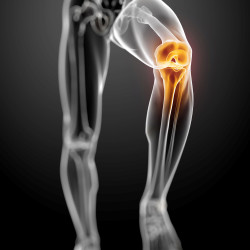
Total knee replacement is a surgical procedure that replaces the diseased and painful surfaces of the knee with artificial parts. Typically the end of the thigh bone (femur), the top of the shin bone (tibia) and the joint surface of the kneecap (patella) are all replaced. The internal cruciate ligaments are usually sacrificed while keeping the surrounding support structures and ligaments intact. Although the intelligent designs of knee replacements aim to replicate a natural knee’s kinematics, patients don’t often feel that the knee is ‘normal’. It is however usually much better than the diseased and painful knee prior to surgery.
A total knee replacement aims to correct the deformity about the knee (knocked knees or bowed legged knees), and to remove painful diseased surfaces of the knee to achieve pain relief.
A cut is usually made over the front of the knee to perform the operation. It goes from above the kneecap down to the top of the shin bone and usually measures about 20cms. The length of the incision will vary between patients. The knee is then exposed by making a cut in the lining of the knee joint itself. Typically a computer is then employed to assist with the bone preparation. The diseased surfaces of the knee are removed and then resurfaced with artificial components. These components are secured to the bone by using special bone cement. The knee is then repaired and wound closed with dissolving sutures.
FAQ
How long will my total knee replacement last for?
This important question is almost impossible to answer because there are many factors that influence the longevity of a well performing total knee replacement. Some of these include age, gender and diagnosis of the patients, the type of prosthesis and surgical techniques used. Superimposed on this is rapid rate of change in medical technology.
The Australian National Joint Replacement Registry records the details of every joint replacement performed in Australia and has collected such details since 1999.
As a general guide, the published rate for patients who require a second procedure on the same knee for any reason is 9.5% at 14 years. In other words, more than 90 people out of a 100 who had a total knee replacement 14 years ago still have the original knee in place. It is not unusual to see the modern knee replacements lasting into the second decade or even the third. It is important to understand that everyone is different and that the technology is rapidly changing to improve overall outcome and survivorship of these implants.
What won’t I be able to do after a knee replacement?
A well functioning total knee replacement should allow you to return to almost all activities except for high impact sports such as jogging, football and soccer. For specific sporting enquiries, please discuss them with your surgeon.
Some of the recommended sports include, cycling, swimming and using a cross trainer. We often see people return to bush or urban walking, social tennis, bowls etc.
Driving after total knee replacement
As soon as you feel comfortable and confident in walking unassisted, you should be able to return to driving. Our Australian Orthopaedic Association recommends a minimum of 6 weeks of no driving after knee replacement surgery.



